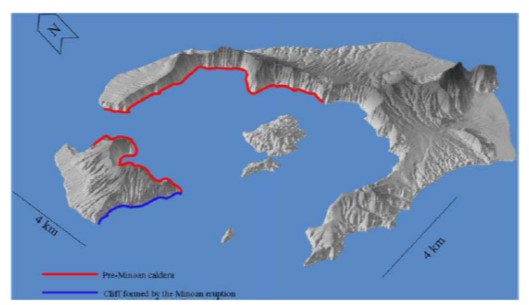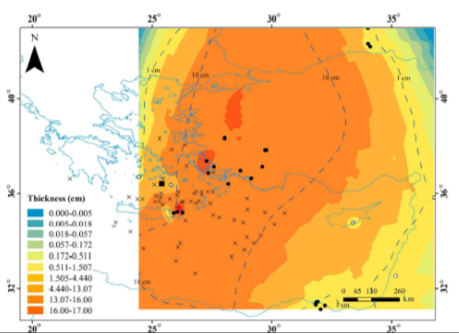C Athanassas (OT-Med post-doc)
D.L. Bourlès (LN2C, CEREGE)
T. Druit (Laboratoire Magmas et Volcans, Clermont-Ferrand, France)
P. Nomikou (Department of Geology, Athens Univ.)
K. Theodorakopoulou (Department of Geological Sciences, National Technical University of Athens)
M.C. Alçiçek (Department of Geology, Pamukkale University, Turkey)
The Minoan eruption of the volcano of Santorini, which occurred in around the 17th Century BC, not only shuddered the status quo of the thalassocratic Minoan empire but also modified the paleotopography of the most prominent volcanic landform on the island: the caldera. Volcanic landforms interact with comic rays and generate through nuclear reactions in situ comogenic nuclides (notably 36Cl, 10Be and 26Al) which accumulate proportionally to the exposure duration. The concentration of in situ cosmogenic nuclides is sensitive to topographic changes. Modeling the production of cosmogenic nuclides in surface rocks may enable the decipherment of geomorphic changes induced by the Minoan eruption in the volcanic terrain of Santorini. Having taken into account the magnitude of morphological changes on Santorini, attempts will be made to assess the impact of the Minoan eruption on the vital space of the Minoan civilization.
1. Cosmic ray exposure (CRE) dating was performed on the caldera cliffs of Santorini with the aim of detecting cliff segments predating the Minoan eruption (17th century BCE). The methodology involved the determination of in situ-produced cosmogenic 36Cl concentration in basaltic-to- rhyodacitic whole rocks cropping out in the cliffs. Current CRE ages demonstrate that an ancient caldera existed on pre-Minoan Santorini, occupying at least half of the modern-day caldera.
2. We employed geostatistics to produce a prediction map for the thickness of the Minoan tephra fallout over the Eastern Mediterranean, and we reconstructed the effects by comparisons with recent eruption analogues. In general, the prediction map shows that the great bulk of the tephra fell on eastern Crete, the eastern Aegean, with higher impact on the Dodecanese, and western Anatolia. Lesser amounts of tephra fell in East Thrace and the Nile Delta.

The outline of an ancient caldera existing on Santorini prior to the Minoan Eruption, determined by cosmogenic 36Cl-dating

Geostatistical interpolation of the extent of Minoan tephra from Santorini over the Eastern Mediterranean


